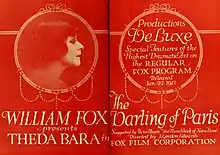The Darling of Paris
The Darling of Paris is a 1917 American silent romantic drama film directed by J. Gordon Edwards and starring Theda Bara and Glen White. It was a very loose film adaptation of the 1831 novel The Hunchback of Notre-Dame by Victor Hugo. It was produced by William Fox. The Darling of Paris was later re-edited from six to five reels and re-released by Fox on February 16, 1919. The film is now considered lost.[1]
| The Darling of Paris | |
|---|---|
 | |
| Directed by | J. Gordon Edwards |
| Written by | Adrian Jackson (scenario) |
| Based on | The Hunchback of Notre-Dame by Victor Hugo |
| Produced by | William Fox |
| Starring | Theda Bara Glen White |
| Cinematography | Phil Rosen |
| Distributed by | Fox Film Corporation |
Release date |
|
Running time | 60 minutes |
| Country | United States |
| Languages | Silent English intertitles |
Plot
The wealthy girl Esmeralda (Theda Bara) is kidnapped by gypsies at birth and becomes, as one might assume, the darling of Paris. She is loved by the bell ringer and former hunchback Quasimodo (Glen White), Frollo (Walter Law), the wicked surgeon who cares for him, and an equally wicked Captain Phoebus (Herbert Heyes).
However, the titular hunchback is downplayed in favor of gypsy dancing girl Esmerelda. The surgeon kills the Captain and frames Esmeralda, but after many merry mix-ups, she winds back with her wealthy family, happily wed to Quasimodo.
Cast
| Theda Bara | Esmeralda |
| Glen White | Quasimodo |
| Walter Law | Claude Frollo |
| Herbert Heyes | Captain Phoebus |
| Carey Lee | Paquette |
| John Webb Dillon | Clopin Trouillefou |
| Louis Dean | Pierre Gringoire |
| Alice Gale | Gypsy Queen |
Production notes
The film was shot at the Fox Studios then located in Fort Lee, New Jersey. An elaborate set was constructed on the back lot to recreate Paris where the film is set. The set also included a reproduction of the Notre Dame de Paris.[2]
Brazil
The release in Brazil was done with the title A Favorita de Paris on September 17, 1917, on the cinemas Ideal[3] and Pathé, both from Rua da Carioca 60–62, Rio de Janeiro. It also debuted on Cine Haddock Lobo on September 30, 1917.[4] Cinema Haddock Lobo was located near the Largo da Segunda-Feira, in a street of several theaters. Cine Ideal belonged to the group Severiano Ribeiro, which still holds in its storehouse old silent films. For over a month it grossed a huge box office and was a success of public and critical acclamation on Rio society.
The highest-grossing releases in September on Rio:
| Release | Cinema | Film | Leading | Enterprise |
|---|---|---|---|---|
| Sept. 17, 1917 | ODEON | Em Casa Alheia (A Kentucky Cinderella) | Ruth Clifford | Bluebird Photoplays |
| Sept. 17, 1917 | PALAIS | Implacável Destino (The Gown of Destiny) | Alma Rubens | Triangle Film Corporation |
| Sept. 17, 1917 | PATHÉ | A Favorita de Paris (The Darling of Paris) | Theda Bara | Fox-Film |
| Sept. 17, 1917 | IDEAL | A Favorita de Paris (The Darling of Paris) | Theda Bara | Fox-Film |
| Sept. 17, 1917 | AVENIDA | A Cruz da Vitória (The Victoria Cross) | Lou Tellegen | Jesse L. Lasky Feature Play Company |
| Sept. 10, 1917 | PARISIENSE | Os Maridos da Divorciada (The Men She Married) | Gail Kane, Montagu Love | Peerless Productions |
| Sept. 03, 1917 | OLYMPIA | Palermas e Malandrins (Haystacks and Steeples) | Bobby Vernon, Gloria Swanson | Keystone Film Company |
| Aug. 20, 1917 | VELO | Vítima da Tentação (Her Temptation) | Gladys Brockwell | Fox-Film |
| Aug. 20, 1917 | ESTRELLA | Porta do Amor (A Love Case) | Harry Depp | Triangle Film Corporation |
| Aug. 13, 1917 | ÍRIS | Judex (Judex) | René Cresté | Société des Etablissements L. Gaumont |
See also
References
- "Silent Era: Darling of Paris". silentera. Retrieved 2012-10-10.
- Fort Lee: Birthplace of the Motion Picture Industry. Arcadia Publishing. 2006. p. 34. ISBN 0-738-54501-5.
- A FAVORITA DE PARIS (The Darling of Paris) Brazil release Cine Ideal: Sept. 17, 1917
- A FAVORITA DE PARIS (The Darling of Paris) Brazil release Cine Haddock Lobo: Sept. 30, 1917